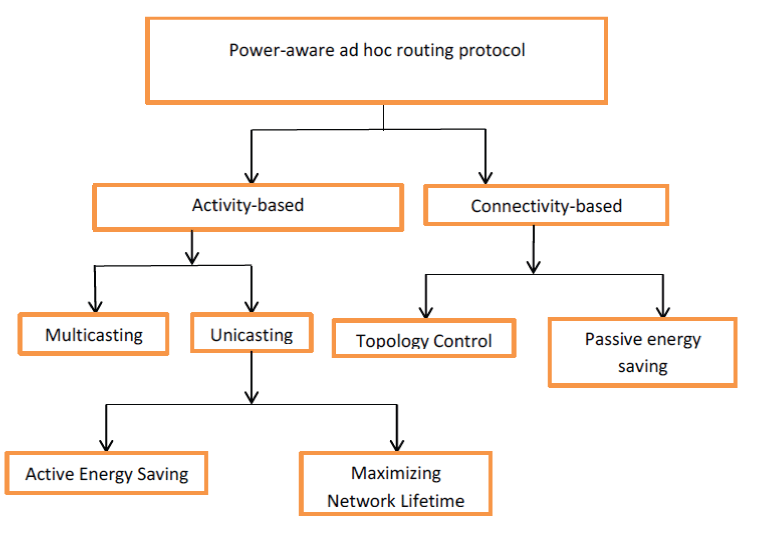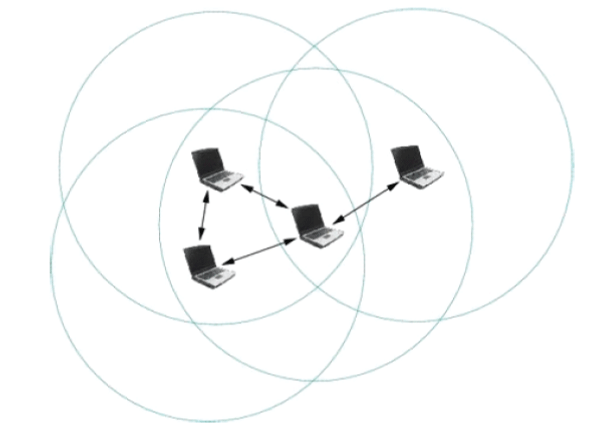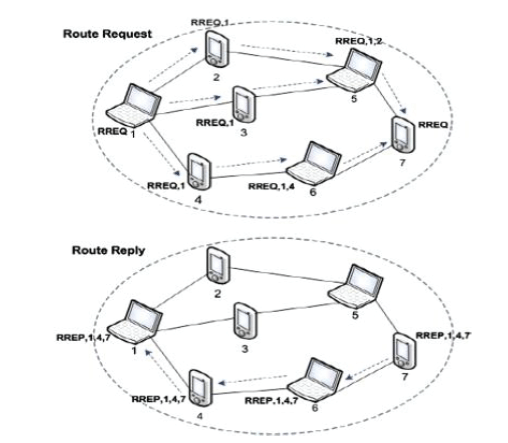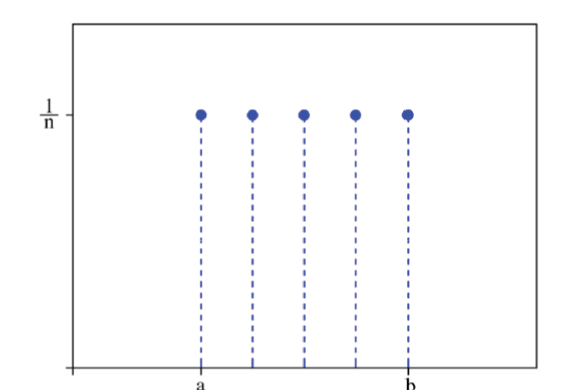Keywords
|
| MANET, DSR, Lifetime, Enhancement, Initial Energy, Nodes. |
INTRODUCTION
|
| The explosion of wireless communication and mobile devices in recent years has opened the door of research on selforganizing networks that do not require a pre-established infrastructure. Ad hoc wireless networks are comparatively new paradigm in multi-hop wireless networking that is increasingly becoming popular and will become an essential part of the computing environment consisting of infrastructure and infrastructure less mobile networks. Different categorization of power aware routing protocols are shown in figure 1. The credit for growth of ad hoc network goes to its self organizing and self configuring properties. All nodes in a MANET basically function as mobile routers participating in some routing protocol required for deciding and maintaining the routes. Routing is one of the key issues in MANETs due to their highly dynamic and distributed nature. Ad hoc routing algorithms broadly can be categorized into pro-active and on-demand routing algorithm. The on demand routing algorithms initiate to find out the suitable route when a route is requested. The proactive routing algorithm exchanges routing information periodically and generates the routing table in advance of route request. These protocols select the routes based on the metrics of minimum hop count. A mobile node which lies outside the transmission of its specific destination would need to relay its information flow through other mobile nodes. This implies that mobile nodes in Ad Hoc networks bear routing functionality so that they can act both as routers and hosts. In Mobile Ad Hoc networks the nodes are dynamically change their position. An Ad Hoc network can be used in an area where infrastructures for mobile communication are not available probably due to high deployment costs or disaster destruction.Due to the lack of infrastructure and the limited transmission range of a node in a mobile ad hoc network, a node has to rely on neighbour nodes to route a packet to the destination node. In specific, all network functions are based on the node cooperation. Currently, routing protocols for mobile ad hoc network, such as the Dynamic Source Routing (DSR) and the Ad hoc On Demand Distance Vector Routing Protocol (AODV) are based on the assumption that all nodes will cooperate. And without node cooperation, in a wireless ad hoc network, no route can be established; no packet can be forwarded, let alone any network applications.The main goal is to balance the energy usage among the nodes and to maximize the network lifetime by avoiding over-utilized nodes when selecting a routing path. |
| The figure 2 shows an ad hoc network having four nodes with its ranges. Among the energy-efficient routing protocols, DSR has been found to be very useful especially in developing new power-aware routing protocols. However, the continuous flooding of route request (RREQ), route reply (RREP) and route error (RERR) packets by the DSR algorithm brings with it high routing overhead that causes substantial energy exhaustion of the nodes. While previous research has looked at minimizing routing overhead as a means to saving node energy in DSR, few if any have looked at controlling the frequency of flooding the RREQ packets. This paper proposes an extension of DSR that looks at controlled and periodic flooding of RREQ packets as opposed to that in the original DSR algorithm based on energy of the node. Two modifications have been done to implement the algorithm in traditional DSR. Firstly, Change the routing algorithm of DSR so that given two nodes between which it necessarily establishes a multi hop path. Statistically you choose, among all the possible ones that passing through the nodes at a given moment have a higher level of energy. Secondly, modify the algorithm so that when the energy of a node that is forwarding data within multi hop path reaches a level less than or equal to a certain threshold percentage of initial energy. The node will ask the neighbours to look for another path for such data to avoid consuming the residual energy in a short time. |
RELATED WORK
|
| A. Energy Efficient MANET Routing Protocol |
| Different routing protocols have been used to establish a correct and efficient route between a pair of nodes. But because of the limited available power of each node, the selected route cannot remain for a long time so that the sourcedestination pair can use it for its successful communication. To achieve the goal of getting longer lifetime for a network, we should minimize nodes energy not only during active communication but also when they are in inactive state. Two approaches to minimize the active communication energy are: |
| ïÃâ÷ Transmission Power Control Approach: A routing algorithm essentially involves finding an optimal route on a given network graph where a vertex represents a mobile node and an edge represents a wireless link between two end nodes that are within each other’s radio transmission range. When a node’s radio transmission power is controllable their direct communication ranges as well as the number of its immediate neighbours are also adjustable. While stronger transmission power increases the transmission range and reduces the hop count to the destination, weaker transmission power makes the topology sparse which may result in network partitioning and high end-to-end delay due to a larger hop count. |
| ïÃâ÷ Load Distribution Approach: The specific goal of the load distribution approach is to balance the energy usage of all mobile nodes by selecting a route with underutilized nodes rather than the shortest route. This may result in longer routes but packets are routed only through energy rich intermediate nodes. Protocols based on this approach do not necessarily provide the lowest energy route but prevent certain nodes from being overloaded and thus ensures longer network lifetime. |
| ïÃâ÷ Sleep/Power-Down Mode Approach: The sleep/power-down mode approach focuses on inactive time of communication. Since most radio hardware supports a number of low power states, it is desirable to put the radio subsystem into the sleep state or simply turn it off to save energy. |
| B. Power Consumption Modes |
| The mobile nodes in wireless mobile ad hoc network are connected to other mobile nodes. These nodes are free to transmit and receive the data packet to or from other nodes and require energy to such activity. The sources of power consumption are communication and computation with communication often being the chief power consumer. Although significant in terms of reducing the power consumption in the wireless transmitter of a sender, it does little to conserve power among the other nodes receivers, forwarders and nodes not involved in this communication. The total energy of nodes is spent in following modes: |
| ïÃâ÷ Transmission Mode: A node is said in transmission mode when it sends data packet to other nodes in network. These nodes require energy to transmit data packet, such energy is called Transmission Energy (Tx) of that nodes. Transmission energy is depended on size of data packet (in Bits), means when the size of a data packet is increased the required transmission energy is also increased. The transmission energy can be formulated as: |
 |
 |
| where Tx the Transmission Energy, PT is the Transmission Power, Tt is time taken to transmit data packet and Plength is length of data packet in bits. |
| ïÃâ÷ Reception Mode: When a node receives a data packet from other nodes then it is said to be in Reception Mode and the energy taken to receive packet is called Reception Energy (Rx) .Then reception energy can be given as: |
 |
 |
| Where Rx is a reception energy, PR is a reception power, Tr is a time taken to receive data packet and Plength is length of data packets in bits. |
| ïÃâ÷ Idle Mode: In this mode generally the node is neither transmitting nor receiving any data packets. But this mode consumes power because the nodes have to listen to the wireless medium continuously in order to detect a packet that it should receive so that the node can then switch into receive mode from idle mode. This amount approaches the amount that is consumed in the receive operation. Idle energy is a wasted energy that should be eliminated or reduced. Then power consumed in Idle Mode is: |
 |
| Where PI is power consumed in Idle Mode and PR is the power consumed in Reception Mode. |
| ïÃâ÷ Overhearing Mode: When a node receives data packets that are not destined for it, then it said to be in overhearing mode and it may consume the energy used in receiving mode. Unnecessarily receiving such packets will cause energy consumption. Then power consumed in overhearing mode is: |
 |
DYNAMIC SOURCE ROUTING PROTOCOL
|
| The Dynamic Source Routing protocol is a simple and efficient routing protocol designed specifically for use in multihop mobile ad hoc networks. DSR is a popular flat on demand reactive ad hoc routing protocol which benefits from very quick adaptation to routing changes and frequent host movements. Sender of the packet knows the complete sequence of nodes through which packets must pass to the destination. One of the primary characteristics of DSR is that it is a source routing protocol instead of being forwarded hop by hop data packets contain strict source routes that specify each node along the path to the destination. Route request (RREQ) and route reply (RREP) packets accumulate source routes so that once a route is discovered, the source learns the entire source route and can place that route into subsequent data packets.The figure 3 shows the procedure of DSR protocol. |
| A.Route Discovery: This mechanism is launched whenever a node wishes to send or contact a destination node which isn’t in its transmission range therefore it must obtain a route to that node by launching the Route discovery mechanism. Figure shows the Route discovery mechanism. Normally the sender must first search this route in its route cache if there is no route it proceeds as follow: |
| It creates a route request packets containing its address and the address of the destination node then it broadcast this packet to all its neighbors using flooding.Each neighbour when receiving this request consults its cache to find an eventual route to this destination to be returned back to the sender otherwise it rebroadcast the same route request to all its neighbours after adding its address to the header of the route request and learns from this request information to be added to its cache. If the node has already treated this route request it ignores the new received request by verifying its sequence number since each route request is identified by a unique sequence number.The same procedure is executed by each neighbouring node until the route request arrives to destination which adds its address at the end of the header and sends a route reply. |
| B. Route Reply:The Figure 3 shows the Route reply mechanism. This procedure is executed by a node after receiving a route request destined to him thus this node executes the following actions: |
| C. Route Maintenance: When forwarding a packet each intermediate node is responsible for confirming that the packet is correctly received by the next node. Whenever this number of attempts was reached this node consider this link as broken than it deletes each route containing this link from its cache than it generates a route error packet to inform the source node and all intermediate nodes about this link failure in the same way each intermediate node deletes all routes containing this route until the route error packet arrives to its destination which chooses to launch a new route request or to find a new route in its route cache. |
| D. Route Cache: The route cache in DSR is used to maintain frequently used routes in order to avoid new route discovery mechanism which consumes lot of network resources in the way that each new discovered route is saved in the route cache of the corresponding node for future use, a node can also learns from route request to add new routes to its cache it also learns from route error packets to update its cache. |
PROPOSED METHODOLOGIES
|
| There are two ways suggested for the modification in traditional DSR algorithm for the enhancement of lifetime of MANET. The figure 4 shows the uniform distribution of discrete probabilities of choosing the route for nodes. These are discussed below with their implications. |
| A. In DSR algorithm, when a node receives a Route Request of which it is not on final recipient, before forwarding, it broadcasts to neighbouring nodes. It waits for a time interval pseudo random selected from uniform distribution of probabilities between 0 and constant "broadcastJitter". The idea behind PADSR is that this delay, instead of being random, should be inversely proportional to a level of energy residual of node in that moment. In this way the first RREQ that will come to node D(hypothetical destination) will be the one which was channelled through the best route from the overall energy point of view in the sense of the sum of energy levels of the intermediate nodes and maximum comparisons to all other possible paths from S(source) to D(destination).Consequently, the total delay between the sending of the RREQ by S and receiving by D is minimum. Despite these changes it is aimed at maintaining the connectivity between nodes not directly communicating. The PADSR does not guarantee that S will always choose the best absolute path from the energy point of view in an element where it remains probabilistic algorithm. The probabilistic algorithm is represented by the delay which is caused by sending the route reply to D by S.The delay turns out to be pseudo random being uniformly distributed between 0 and 0.01. So, if there are two similar paths in terms of energy, despite a RREQ arrivals to D before sending of the corresponding RREP containing the path better from the energy point of view, is delayed more than another RREP containing path slightly less favourable. Furthermore, the length of the paths influence the delay forwarding for which paths with greater energy but more long paths can be penalised compared to more short but with less energy. |
| B. In the traditional DSR algorithm, once a certain path is chosen for sending a stream of packets to a certain destination it tends to be used until one or more nodes that composing are no longer available (consume all their energy, moving outside the range of neighbouring nodes etc...). The difference in consumption changes from NIC to NIC but the otcl class "EnergyModel" allows you to specify these values in phase of creation of nodes. Since a node consumes more energy in transmission and reception.The phenomenon may not be desirable. This is so because some of these nodes could have data to transmit and due to lack of energy would not be able to do so.It is desirable to maintain a balance in the energy consumption of nodes. The consequent loss connection which sooner or later leads to the division of the network into two or more partitions not communicating. To end this, it is introduced a second enhancement for DSR in which the node accepts the packet depending on certain threshold percentange of initial energy. Think of this process as a sort of "survival instinct" of each node when it reaches a low level of energy. |
SIMULATION
|
| The reference topology of the simulations, conducted in order to verify the advantage deriving by the use of Power Aware DSR and Power Survival DSR. It consists of a ad-hoc network of 11 nodes. They are in a fixed position. There is FTP traffic between the node most left (client node 0) and the most right (server node 10) not directly communicating. The node 0 (client) attempts to contact the node 10 at time 0.1 s establishing a TCP connection to the above which is made to pass the FTP traffic. Results were analyzed via xgraph and NAM visualization using the generated trace files and nam files. Starting with initial energies of the different nodes and repeated each simulation various times. At the end of each set of simulations, some procedures Tcl analyse the trace file generated. We compared the performance of our enhancement with the original method while assuming different initial energy of nodes. Starting with initial energies of the different nodes and repeated each simulation 300 times, 100 for each routing algorithm defined. By calculating the mean values as well as the confidence intervals at 90% of some events, indicative of the capacity of the network to survive over time such as: |
| ïÃâ÷ The fall time of the last link between two nodes. |
| ïÃâ÷ Energy depletion time of the first node. |
| ïÃâ÷ Energy depletion time of the last node. |
| ïÃâ÷ Last sequence number received from the node 10 and confirmed by ACK to node 0. This metric is used to assess the amount of data at the transport layer that are actually exchanged between the node 0 and node 10 not counting the traffic control and retransmissions. |
| ïÃâ÷ Life time of the network transport level, defined as the difference between the time of receipt of last ACK sent from node 10 to node 0 and the time of transmission of the first segment TCP from node 0 to node 10. |
| For each of these output parameters, and for the three cases of use of the DSR, Power Aware DSR and DSR Survival, the respective means are compared. It is estimated the increase / decrease relative to purpose of assess any improvement or worsening. In our simulations, the activation threshold of the procedure for survival DSR has been configured to 20%.The results of simulation have been enumerated in table 1, table 2 and table 3 with different initial energy of nodes.These results are taken into consideration for determining the effectiveness of the proposed modification in DSR protocol. If we look into the table 3 of initial energy of nodes 3J, it is strange about the last time energy depletion of node. The improvement induced by the use of DSRSurvival was much less than that induced by PADSR. This was because, in the scenario of low energy, DSRSurvival intervened to a very low level of energy (20% in our simulation of 3J is 0.6J) induced too much instability in the network. Thereby generating traffic control in response to the apparent change of topology that consumed little energy left at the nodes involved. When we set the initial energy of nodes asymmetrical, it was found that the traditional DSR seemed to behave better. The only parameter whose value increased was average Time, energy depletion of the first node. |
CONCLUSION
|
| A novel energy aware multipath routing protocol has been proposed (PADSR and Survival DSR). It has been integrated with different energy metrics. The proposed protocol is mainly useful for enhancing the lifetime of MANET regardless of the quantity of data exchanged. It has been tested under conditions of different initial energies of nodes. At lower initial energies, it behaves considerably better as compared to higher energies of the concerned nodes. The performance of PADSR is better than Survival DSR as it induces less instability. However, if we set the values of initial energies of nodes asymmetrical the performance of proposed protocol degrades. The only parameter we find improvement in energy depletion of first node. We have shown that it is feasible to build such a protocol to run on real embedded platform while there are many improvements that can be made to our design and implementation. The protocol does not seem to behave effectively at higher energy of nodes. There is a limitation of the protocol that under different conditions of initial energy, even PADSR seems to behave worse than traditional DSR. In order to maximise thelifetime of a node, the selection of optimal path is based entirely on the initial energy of the node. This point is considered valid in the proposed protocol to increase the overall lifetime of MANET. |
Tables at a glance
|
|
|
| |
Figures at a glance
|
 |
 |
 |
 |
| Figure 1 |
Figure 2 |
Figure 3 |
Figure 4 |
|
| |
References
|
- Goldsmith AJ and Wicker SB, “Design challenges for energy-constrained ad hoc wireless networks”, IEEE Wireless Communications 2002,Vol. 9, Issue 4, PP. 8–27.
- D. B. Johnson and D. A Maltz, "Dynamic Source Routing in ad hoc wireless networks." in Mobile computing (Imielinski and Korth, eds), vol.353. Kluwer Academic Publishers, 1996.
- V. Rishiwal, M. Yadav, S. Verma, S. K. Bajapai, “Power Aware Routing in Ad Hoc Wireless Networks”, Journal of Computer Scienceand Technology, Vol. 9, Issue. 2, PP. 101-109, Oct. 2009.
- Yu-Chee Tseng, Chih-Shun Hsu, Ten-Yueng Hsieh, ” Power Saving Protocolsfor IEEE 802.11 Based Multi-Hop Ad Hoc Networks” ,ComputerNetworks: The International Journal of Computer and Telecommunications Networking, Volume 43, Issue3, Pages 317-337, 2003.
- D.Kim, et al., “Routing Mechanisms for Mobile Ad Hoc Networks Based on the Energy DrainRate” IEEE Trans.on Mob. Comp, vol. 2, no. 2,Apr-June 2003
- L. Abusalah, A. Khokhar, M. Guizani, "A survey of secure mobile AdHoc routing protocols," IEEE Communications Surveys & Tutorials, vol.10, no. 4, pp. 78-93, 2008.
- M. Weeks and G. Altun, "Efficient, Secure, Dynamic Source Routingfor Ad-hoc Networks," Journal of Network and Systems Management,Vol.14, No. 4, pp. 559- 581, Dec. 2006.
- G. Acs, L. Buttyan, I. Vajda, "Provably Secure On-Demand SourceRouting in Mobile Ad Hoc Networks," IEEE Trans. MobileComputing, vol.5, no. 11, pp. 1533-1546, Nov. 2006.
- P.S.Hiremath, ShrihariM.Joshi, “Energy Efficient Routing Protocol withAdaptive Fuzzy Threshold Energy for MANETs”, InternationalJournal of Computer Networks and Wireless Communications (IJCNWC), ISSN: 2250-3501 Vol. 2, No. 3, June 2012.
- Niranjan Kumar Ray, Ashok Kumar Turuk, “Energy Efficient Technique for Wireless Ad hoc Network”, 1st International Joint Conferenceon Information and Communication Technology, PP. 105-111, Jan. 2010.
- Yu Wang, Wen-Zhan Song, Weizhao Wang, Xiang-Yang Li and Teresa A. Dahlberg, “ LEARN: Localized Energy Aware RestrictedNeighbourhood Routing for Ad-hoc Networks”,3rd Annual IEEE Communications Society Conference on Sensor, Mesh and Ad-hocCommunications, 2006.
|